T0@st
News Editor
- Joined
- Mar 7, 2023
- Messages
- 3,063 (3.89/day)
- Location
- South East, UK
| System Name | The TPU Typewriter |
|---|---|
| Processor | AMD Ryzen 5 5600 (non-X) |
| Motherboard | GIGABYTE B550M DS3H Micro ATX |
| Cooling | DeepCool AS500 |
| Memory | Kingston Fury Renegade RGB 32 GB (2 x 16 GB) DDR4-3600 CL16 |
| Video Card(s) | PowerColor Radeon RX 7800 XT 16 GB Hellhound OC |
| Storage | Samsung 980 Pro 1 TB M.2-2280 PCIe 4.0 X4 NVME SSD |
| Display(s) | Lenovo Legion Y27q-20 27" QHD IPS monitor |
| Case | GameMax Spark M-ATX (re-badged Jonsbo D30) |
| Audio Device(s) | FiiO K7 Desktop DAC/Amp + Philips Fidelio X3 headphones, or ARTTI T10 Planar IEMs |
| Power Supply | ADATA XPG CORE Reactor 650 W 80+ Gold ATX |
| Mouse | Roccat Kone Pro Air |
| Keyboard | Cooler Master MasterKeys Pro L |
| Software | Windows 10 64-bit Home Edition |
AMD has announced the immediate availability of its Ryzen 7045 HX-series (Dragon Range) processors for high performance laptop devices. In a Youtube video released on March 10, AMD's Jason Banta has announced the availability of the world's most powerful mobile processor, the Ryzen 9 7945HX. He listed the OEM partners who have integrated the 7945HX into flagship level laptop models. He also declared that this range topping CPU is a competition beater. Gaming benchmark tests have demonstrated that the Ryzen 9 7945HX beats Intel's Raptor Lake Core i9-13950HX by an average margin of 10%.
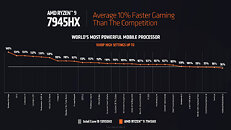
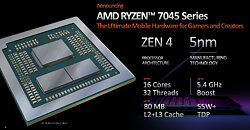
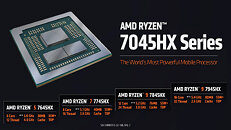
The "Dragon Range" series is comprised of four processor models, the aforementioned Ryzen 9 7945HX is top dog, followed by the 12-core/24-thread Ryzen 9 7845HX, both featuring dual-CCD designs. These are trailed by the single-CCD models, the 8-core/16-thread Ryzen 7 7745HX, and the 6-core/12-thread Ryzen 5 7645HX. The Ryzen 9 7945HX is clocked at a 2.50 GHz base, with a maximum boost frequency of 5.40 GHz. The 7845HX has a 3.00 GHz base frequency, boosting up to 5.20 GHz. The 7745HX ticks at 3.60 GHz base, boosting up to 5.10 GHz. The 7645HX has the highest base frequency at 4.00 GHz, but only boots up to a maximum of 5.00 GHz.
Retail listings for laptops built using the Ryzen 9 7945HX have popped up on Newegg and Amazon. It seems that ASUS is the first company out of the gate to push product to market - with various configurations of its ROG range: Zephyrus Duo 16, Strix SCAR and Strix G17 models are available to purchase right now. At the current time, a basic G17 model will set you back $1799, and the top-of-the-line Zephyrus comes in at a wallet punishing $5145.
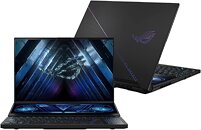
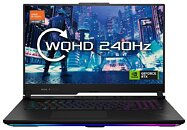
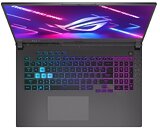
It will be interesting to see whether supply will meet demand, as AMD has been affected by supply chain and manufacturing issues in the recent past, especially during initial product launch periods.
View at TechPowerUp Main Site | Source



The "Dragon Range" series is comprised of four processor models, the aforementioned Ryzen 9 7945HX is top dog, followed by the 12-core/24-thread Ryzen 9 7845HX, both featuring dual-CCD designs. These are trailed by the single-CCD models, the 8-core/16-thread Ryzen 7 7745HX, and the 6-core/12-thread Ryzen 5 7645HX. The Ryzen 9 7945HX is clocked at a 2.50 GHz base, with a maximum boost frequency of 5.40 GHz. The 7845HX has a 3.00 GHz base frequency, boosting up to 5.20 GHz. The 7745HX ticks at 3.60 GHz base, boosting up to 5.10 GHz. The 7645HX has the highest base frequency at 4.00 GHz, but only boots up to a maximum of 5.00 GHz.
Retail listings for laptops built using the Ryzen 9 7945HX have popped up on Newegg and Amazon. It seems that ASUS is the first company out of the gate to push product to market - with various configurations of its ROG range: Zephyrus Duo 16, Strix SCAR and Strix G17 models are available to purchase right now. At the current time, a basic G17 model will set you back $1799, and the top-of-the-line Zephyrus comes in at a wallet punishing $5145.



It will be interesting to see whether supply will meet demand, as AMD has been affected by supply chain and manufacturing issues in the recent past, especially during initial product launch periods.
View at TechPowerUp Main Site | Source








